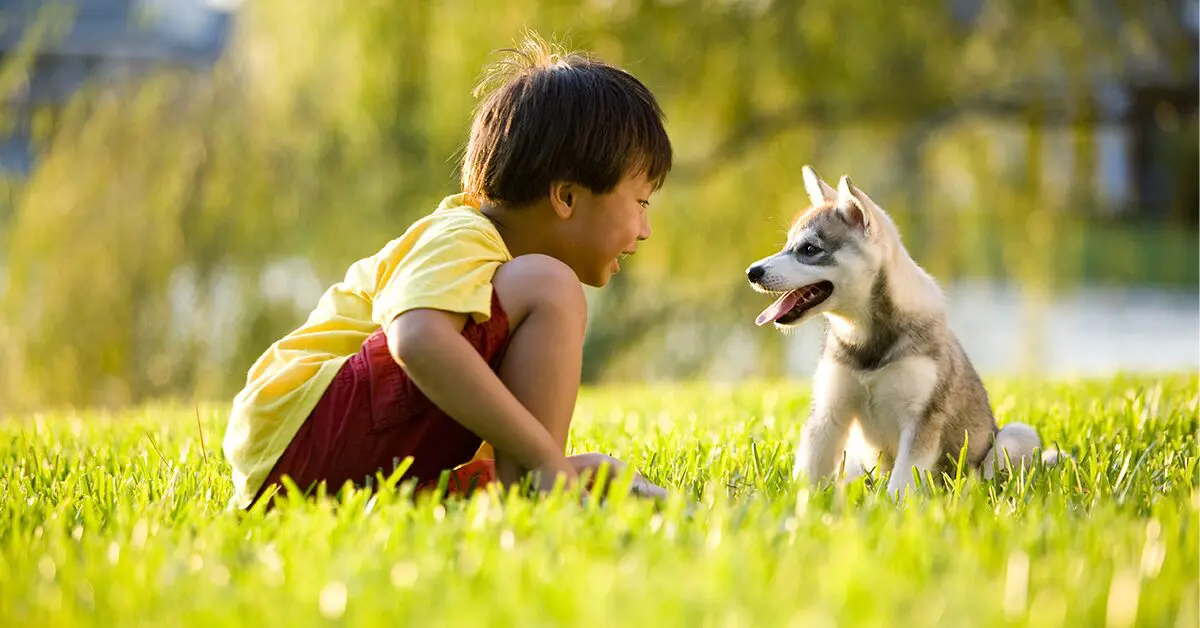Key points
- Safe interactions between puppies and children take patience and work, but proactive training can promote long-term safety and happiness.
- Before you bring your puppy home, be sure to brush up on dog training tips, create a safe place for your puppy, and lay some ground rules with your kids on how to safely handle your puppy.
- It’s important to never leave your puppy and young children unsupervised.
The idyllic image of a new puppy and young child growing up together and becoming best friends is many pet parents’ dream. And although it takes a bit of work, it can definitely become your reality.
Setting your new puppy and young children up for a good relationship takes a lot of patience and proactive training, but the result is well worth it. So, before you bring your new puppy home, learn how to set ground rules with your kids, create safe spaces for interaction, and brush up on your dog training basics.
Let’s dig in!
Brushing up on your dog training skills
In a lot of ways, puppies are just like small children. Every day, they learn a little more about the world around them. From the house rules to how to get along well with others, it’s important to teach our puppies (or new adult dogs) how to navigate new environments the same way we teach our kids. Taking puppy socialization and training seriously (and getting your kids involved if they’re old enough!) is the first step toward a strong relationship between your children and new dogs.
When in doubt, you can always reach out to a professional dog trainer or animal behaviorist for help. Puppies should have early training in basic commands like come, sit, stay, lie down, and leave it.
Tip: Just as we baby-proof our homes in anticipation of a new arrival, it’s important to do the same for your new pooch by puppy-proofing your home. Puppies explore with their mouths and can get into trouble quickly if left unsupervised.
Creating a safe place for your pup
Just like young children, puppies need lots of sleep and time to relax. A crate, exercise pen, or a quiet room with a baby gate can serve as a sanctuary for your new puppy to play, eat, and rest – and take a break from rambunctious children.
Creating a safe place for your pup also helps prevent unsupervised play between your puppy and small children. Puppies can knock over toddlers, and those puppy bites can hurt! Moreover, young children can injure a puppy by picking them up improperly or falling on them. It’s important to teach your kids to leave the puppy alone when eating, sleeping, or relaxing inside their pen or crate.
Tip: Do your best to ensure puppy toys stay in the puppy pen, and children’s toys stay in their play area. A puppy cannot distinguish between their toys and your child’s toy, and the last thing you want is your child’s favorite toy to fall victim to puppy teething. Similarly, small children love putting things in their mouths – just make sure it’s not a slobbery dog toy!
Setting ground rules for puppy play
While you want your children to feel excited about their new family member, putting some rules in place is necessary to keep everyone safe.
Puppies can sometimes be seen as kids’ toys, but children need to understand that their new puppy is a living, breathing animal with emotions and needs! A cuddle may be nice in theory, but a new puppy may not welcome a forced hug – resulting in poor socialization. For example, your puppy may learn to fear hugs, evoking anxious or aggressive behavior in the future.
Implementing rules for safe play not only teaches puppies important socialization skills but also teaches children a thing or two about teamwork and cooperation. Though you can absolutely add to this list depending on your household’s unique needs, here are some basic ground rules for safe interactions between dogs and kids.
1. Always supervise interactions
Never allow interactions between a puppy and children without being present and alert. Injuries can happen in a few moments and leave heartbreak and fear behind. Constant supervision, especially at the beginning of your kids’ and dog’s relationship, is the best way to nurture it. Remember, the puppy stage will pass.
2. Teach little ones to remain calm
Running, jumping, and squealing can do one of two things to a new puppy: a) They can feel threatened by this energy or b) they can feed off of this energy. Your new puppy can get rambunctious and knock over a small child or bite them which never ends well. Teaching your child to remain calm and talk softly when around your pup can help prevent this from happening. And remember – a well-exercised puppy is a calmer puppy.
3. Never force interactions
Your puppy’s socialization is vital, with the largest development between 8-16 weeks of age. However, you never want to force interactions between your children and your puppy. Rambunctious children can be scary, so allowing your puppy to approach your children first will ease their fear. You should also allow your puppy to leave when it needs to. They will slowly develop important social skills and confidence.
4. Use positive reinforcement training
It’s easy to praise our children when they are showing appropriate behavior with a puppy, but don’t forget about your puppy! You can give your puppy training treats to the puppy as a reward for good play sessions. Your puppy will soon learn good things happen when they act calmly around their family.
Tip: Puppies don’t always take treats gently. Laying dog treats on the ground and teaching your children to give them in this way can save them from nipped fingers. Your puppy will learn to take treats gently with time.
5. Teach gentle puppy handling
Even children with the best intentions can accidentally mishandle a puppy – resulting in growling and biting. Never allow your kids to pull or squeeze on your pup’s ears, tail, or legs. Similarly, never allow your puppy to jump, bite, or herd your children. Basic training classes can be helpful if you’re having trouble breaking these bad habits.
Tip: Using a stuffed toy can be very effective for practicing gentle touches and calm voices!
6. Play the “Be a tree” game
When a rambunctious puppy hurts small children, they may yell, cry, or hit the puppy. The puppy may think the noise and activity of your child is a game and make matters worse. However, if you ignore your puppy, they will usually turn to more exciting stimulation like one of their toys. Teaching children to stay still or “be a tree” and call for an adult can keep both of them safer.
7. Watch for signs of overstimulation
Watch for signs of overstimulation during play sessions with kids and puppies. Your puppy will show you if they are getting tired, scared, or uncomfortable by their body language. Being able to read your pup, and respond when you need to, protects both your human and fur kids’ well-being.
8. Be proactive rather than reactive
Each year, 800,000 dog bites require medical attention in the US. Unfortunately, half of these involve children. While this statistic is unsettling, it is avoidable. With thorough preparation and constant supervision and coaching, your kids and puppy will learn to get along just fine. The key is to be proactive in your efforts, rather than sitting back and watching what happens.
By implementing a few of these tips, you’ll be well on your way to training your new puppy to play safely with your kids. There is no denying the magical connection between puppies and children – and it’s one we’re sure you’ll enjoy for years to come.
While we do our best to keep both our human and fur kids safe, sometimes, accidents happen. Whether it’s a swallowed sock or a broken paw, having pet insurance for your dog can help you pay for unexpected injuries or illnesses. Want to see for yourself? Get a quote today – Pumpkin will fetch it for free!




